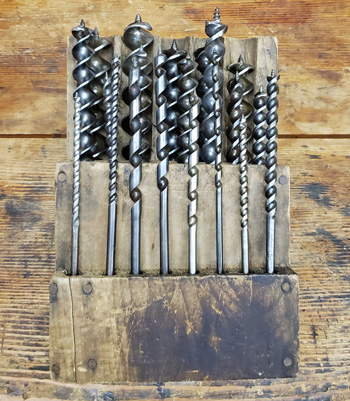Auger Bit Heaven
Brought to you by oldtoolheaven.com
 Most treatments of the American auger bit begin with the 1809 patent of Connecticut resident Ezra L'Hommedieu who is said to have invented a double-twist auger in 1809. The idea is older; a British patent existed as early as 1770. Though documentation is scarce, the honor for the first manufacture of the double twist screw auger in North America likely goes to William Henry and John Henry Rauch of Lancaster County, Pennsylvania, men who put a commercially viable product on the market in 1772.(1)
Most treatments of the American auger bit begin with the 1809 patent of Connecticut resident Ezra L'Hommedieu who is said to have invented a double-twist auger in 1809. The idea is older; a British patent existed as early as 1770. Though documentation is scarce, the honor for the first manufacture of the double twist screw auger in North America likely goes to William Henry and John Henry Rauch of Lancaster County, Pennsylvania, men who put a commercially viable product on the market in 1772.(1)
Job T. Pugh of Philadelphia is reported to have been making double-twist augers in 1774 (he wasn't).(2) There are several other early claimants, among them John Washburn of Kingston, Massachusetts,(3) Thomas Snell of Ware, Massachusetts,(4) and the duo Nathan Palmer and Andrew Hartshorn of Mansfield, Connecticut.(5)
The bits seen here are of the common sizes used by a general-purpose worker. It's unlikely that any would have been used to bore holes in the timbers used to build a barn, frame a ship, or tap a maple tree. The bits in the box range from 6 1/2 to 10 1/2 inches in length, mere babies compared to the ten-foot augers used to bore the timbers for the gates on the locks of the first Panama Canal.
Some of the bits have a single spiral while others have shanks that were flattened and twisted to form what is known as a double-twist bit. In either case, the function of the spiral was the same—to guide waste wood up the shank so that the bit would not have to be pulled from the hole and the chips cleared out to allow for further boring. None of the bits in the box feature the solid center stem popularized by the Irwin Auger Bit Company—not that the design is inherently less interesting—but because none happened to be on hand when the owner put the assemblage together.
As interesting as a comprehensive history of the United States auger bit industry from its earliest days might be, Auger Bit Heaven has not been created for that purpose. The site serves instead, as a venue to explore various aspects of auger bit manufacture that have caught the author's fancy.
Sources:
- Hutchins, Joseph. "The American Screw Auger." The Chronicle of the Early American Industries Association. Vol. 64, no. 3 (September 2011), p. 89-105.
- Hutchins, p. 95.
- Hurd, Hamilton. History of Plymouth County, Massachusetts, with Biographical Sketches of Many of itsPioneers and Prominent Men. Philadelphia : Lewis & Company, 1884. p. 284.
- Chase, Arthur. History of Ware, Massachusetts. Cambridge, Mass. : The University Press, 1911. p. 225.
- Barber, John Warner. Connecticut Historical Collections... New Haven : Durie, Peck & Barber, 1837. p. 587.